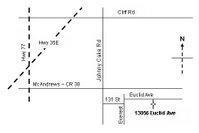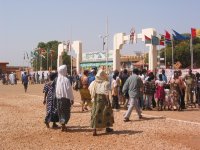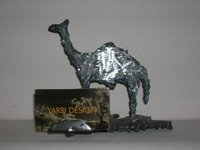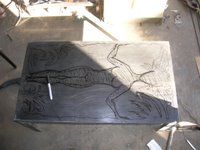My art is modern African furniture and decorative objects inspired by my country,
Saturday, December 30, 2006
Artist Statement
Friday, December 29, 2006
The Art Within Us
In 2006, TAWU participated in the Spring Art Party, Juneteenth, GLBT Pride Festival, Powerhorn Art Fair and Freedom Jazz Festival.
We look forward to working with this group in 2007!
Thursday, December 28, 2006
Wednesday, December 27, 2006
Wakaloni Lamps
This pair of lamps is a Wakaloni man and woman. Rabi created their bodies with metal, while their heads are bronze sconces.
When a Wakaloni meets a human in the forest, he asks this person to wrestle. The person must start to wrestle right away because if the Wakaloni has time, roots grow from their feet into the ground. The person is then unable to wrestle the Wakaloni anymore. If the person is able to beat them, the Wakaloni gives him riches. If the person loses, the Wakaloni turns him into a crazy person.
Rabi doesn't know anyone who has met the Wakaloni. But many people talk about them. Sometimes parents scare their naughty children by threatening that they'll be taken to the forest and the Wakaloni will get them.
Tuesday, December 26, 2006
For Sale
Saturday, December 23, 2006
Kenkayba's Place
864 University Ave (corner of University and Victoria)
St Paul, MN 55104
651-762-9451
The owners of the restaurant are Emmanuel and Cecilia, but Cecilia is the one who cooks and runs the place. They are a super sweet couple and have lived in the US for a number of years. Cecilia added soul food to the menu too, which we haven't tried yet. It's just a treat for us to get fufu and goat stew! My personal favorites are the plantains.
They were recently featured by the Star Tribune since there are a few African restaurants popping up in the metro area. For a guide to Ghanian foods, visit this site.
Sunday, December 10, 2006
Tiim Soba
Rabi's latest sculpture is the "Earth Master" or "Tiim Soba" in Moore.
This man communicates with the ancestors by making sacrifices with lambs, goats and chickens. When making sacrifices he uses sand, potions and writings.

If there is a disease or famine, he asks the ancestors to come help the people. He calls for the rain. When someone dies in the village in a bizarre ways, he is the one who investigates the death.
In most ethnic groups, there is an earth master. Everyone in the village respects this man and many are afraid. He's even well respected by the chief.
Friday, December 08, 2006
Women & Water
 I don't quite know what my obsession is with women and water. If you come to our house, you will find paintings, bronze statues and now some of Rabi's pieces along this theme. It started sometime in Burkina. This is a photo I was lucky to shoot in northern Burkina near Bani in 2003 with my trusty Nikon N70. I love shooting in black and white, though my dad doesn't understand why I would want to since there is color film. The first shot wasn't quite right, but these gals lined up just right in the second. The 3 shorter trees are young baobabs, and the tallest is the shea tree.
I don't quite know what my obsession is with women and water. If you come to our house, you will find paintings, bronze statues and now some of Rabi's pieces along this theme. It started sometime in Burkina. This is a photo I was lucky to shoot in northern Burkina near Bani in 2003 with my trusty Nikon N70. I love shooting in black and white, though my dad doesn't understand why I would want to since there is color film. The first shot wasn't quite right, but these gals lined up just right in the second. The 3 shorter trees are young baobabs, and the tallest is the shea tree.There are many ways to collect water and girls learn how from a young age. Water can be collected in clay jugs, plastic containers or metal bowls. Babies are brought when mothers fetch the water needed for cooking, cleaning and bathing. Water can be pumped, if a village is lucky to have a well with a working pump. It can be drawn up from a well also, with a bucket attached to a rope. It can be collected from a stream, river or pond.
Waterborne illnesses and mosquitoes thrive in open water in Burkina. Most people don't boil their water to kill any parasites because this would require another fuel source. So many children and elders become sick. Malaria is quite common. Being sick is just normal, even though many of the illnesses are preventable. It's just an accepted part of life, like young girls walking an hour for a jug of water.
Wednesday, December 06, 2006
Reminder: Holiday Open House This Weekend!
HOURS
Friday, December 8th at 10am-7pm
Saturday, December 9th at 10am-5pm
Sunday, December 10th at 12pm-4pm
LOCATION
13056 Euclid Ave, Apple Valley, MN
Tel: 952-431-2614
Wednesday, November 29, 2006
School Presentations
One of the fun things that I get to do on a regular basis for my "other" job is present intercultural experiences to high school students. Basically, I work for AFS Intercultural Programs, a high school exchange organization. In order to recruit students to go abroad, I talk to them in their foreign language classes about culture, stereotypes and my time overseas.
Before Rabi had his work permit, he would join me on field trips and would present to classes about
We were also invited to present to my nephews' classes (1st and 3rd grades) in a
Now that he is working full time, he no longer comes on trips with me. But I'm still presenting about Burkina. In this way, I'm fulfilling the Peace Corps' 3rd goal which is "Helping promote a better understanding of other peoples on the part of Americans." Of course I present a bit about my study abroad experience in
During these presentations, I try to impress in these students the magnitude of
I talk about my experiences living with a host family during my training, and the fact that Muslims and Christians lived side by side in my host village. I do talk about the poverty but try to put it into perspective. I explain to them, just as Americans have stereotypes about Africans, the Burkinabes I knew had stereotypes of Americans. How many people did I talk to in Burkina that could not believe there are people living on the streets in the
So, I may be kidding myself that I am in some way making a difference. But if one kid leaves my presentation with a desire to learn or experience a new culture (be it through a high school exchange, college study abroad, or the Peace Corps), then I am jazzed about my work. And if they will one day recall that the capital of Burkina is

Monday, November 20, 2006
Update on GlobalGiving Campaign
Last Friday afternoon, I called GlobalGiving (GG) to get an update on the extraordinary opportunity for the NEEED/FBF project to be awarded $5,000 from an anonymous donor. The good news is that we are little over half way towards qualifying for this award by having 100 donors contribute to this project by December 15th. To date, 54 FBF friends have made contributions! The not-so-good news is that the rate at which donations have been made coming in fell rapidly this past week, with only 2 contributions being received last Tuesday and Wednesday and 1 contribution received on Thursday and on Friday. This is not a good sign. I am concerned that we might not reach our goal. And reaching this goal is important, not only for the girls at school but also for the NPCA, the RPCV community, and, I believe, the Peace Corps. See, http://www.globalgiving.com/npca.html
Given the state of affairs, I'd like to ask that those of you, who have not yet made a gift to our project on the GG website, consider making a small donation NOW-- before it slips the mind and before it is too late. I, for one, am going to following Jon Berger's advice. Jon promised to approach his wife and kids about making a donation. This next week, my children are coming home from Thanksgiving. I can't think of a better time to ask them to give a-little-something. And I’ve just gotten a pledge from my wife who promises to make a small donation to the GG project. Spread the good news about this exciting opportunity among close friends and family.
Please donate $10 today!
Sunday, November 19, 2006
Holiday Open House
Yarbi Design and Alsadu, Inc celebrate the coming holiday season by inviting you to view one of a kind gift selections of new and antique items.
HOURS
Friday, December 8th at 10am-7pm
Saturday, December 9th at 10am-5pm
Sunday, December 10th at 12pm-4pm
LOCATION
Tel: 952-431-2614
Wonderful World
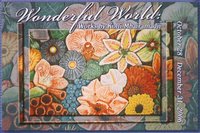
Wonderful World: Works by Koffi Mbairamadji
October 28-December 31, 2006
Obsidian Arts
2948 Chicago Ave, Mpls
Open Saturdays from 12-4pm or by app't
Please visit the show Wonderful World: Works by Koffi Mbairamadji. Koffi's work tells a refreshingly vibrant story of living and forms. Dancing among flowers, animals, instruments, and spiritual images in his journey...and a journey of familiar recognition for those who are drawn into his works. Born in Chad, Koffi started painting years ago as a hobby. Today it is part of his daily life.
The show is at Obsidian Arts. Obsidian Arts is a Minnesota non-profit arts space focused on celebration and development of black artists, arts institutions and artwork.
There will be an artist talk Saturday, December 9th at 4-5:30pm. Come support our friend Koffi!
Sunday, November 12, 2006
Femme Libre
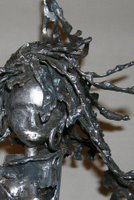 Rabi ended up entering his piece "Femme Libre" into the NEMAA's Fall Fine Arts Show, which ran this weekend.
Rabi ended up entering his piece "Femme Libre" into the NEMAA's Fall Fine Arts Show, which ran this weekend.He said his inspiration for the sculpture was from gender differences. Men in Burkina Faso, and in Africa in general, can do whatever they want; they can wear whatever clothes they want, can go wherever they want. But women can't.
When a woman actually does what she wants -- wears what she wants -- people criticize her and treat her poorly. However, there are some women that do what they want.
They are "femme libre" or free women.
Saturday, November 11, 2006
SIAO
 I cannot believe I haven't written about Salon International de l'Artisanat de Ouagadougou (SIAO), and it's already finished! The 10th SIAO (International Arts and Handicrafts Trade Show of Ouagadougou in English) was held Oct 27-Nov 5, 2006. An estimated 2,500 artisans and 500,000 public visitors attended. This year's theme was "African handicrafts and fair trade."
I cannot believe I haven't written about Salon International de l'Artisanat de Ouagadougou (SIAO), and it's already finished! The 10th SIAO (International Arts and Handicrafts Trade Show of Ouagadougou in English) was held Oct 27-Nov 5, 2006. An estimated 2,500 artisans and 500,000 public visitors attended. This year's theme was "African handicrafts and fair trade."The first one was held in 1984 and allowed the government to assess the interest in Burkinabe products by Americans and Europeans. It was a success so the first edition was held in 1988. Since then, the show is every even year, starts the last weekend of October, goes for 10 days, and features crafts from many African nations. Handicrafts available include bronze statues, hand-woven textiles, leatherwork, ethnic jewelry, colorful pottery, ceramics, calabash toys and many more.
I have only been to 1 SIAO, in 2002. This is where I first met Sidonie and bought my 1st of many Sidonie bags (a yellow one with purple embroidered flowers). It was awesome to see all the different handicrafts and works of art from around the continent. One of my favorite purchases was a hand painted gourd by a Burkinabe artist; he made some of his pieces right on the spot. I had a lot of fun wading through yards and yards of Mauritanian fabric as well. I felt like a kid in a candy shop! Local eats were also available, and different dance troupes and musicians performed. It was a very festive environment.
I'm pretty bummed that we weren't able to go this year, as planned, considering this year's theme. But, we have it on our calendars for 2008! Vous être invite.
Friday, November 10, 2006
Friends of Burkina Faso
Stop what you are doing and make a small donation to a Friends of Burkina Faso project!
Earlier this year, Friends of Burkina Faso entered into a National Peace Corps Association-supported partnership with GlobalGiving, an online project clearinghouse. The idea was that by putting one of the projects on GG's website, it could attract more donors than FBF can normally get through their limited membership sphere (I am a member myself).
Given that FBF is one of the first three NPCA affiliates to partner with GlobalGiving, GG just informed FBF leadership yesterday that if they can attract at least 100 on-line donations ($10 minimum) for their project by December 15, 2006, GG will put $5000 towards their "Noon Meal Girl’s Education project.”
The noon meal project is a supplementary project to an earlier one that FBF has been supporting for a few years which provides young girls' families with school supplies and a lamb for the first year of schooling which is then sold the following year to purchase more supplies and a new lamb for the same purpose year-after-year.
To make your donation by 12.15.06 to an innovative FBF community-initiated project in Burkina, please visit the following link: http://www.globalgiving.com/pr/1400/proj1349a.html.
Read more about this campaign at Tony Gambion’s blog or at the NPCA’s website.
Merci en avance!
Sunday, November 05, 2006
Fall Fine Arts Show - Nov 10-12th
Rabi is working on 2 potential pieces. Let us know what you think and which piece he should submit!
#1 is the "Femme Libre" sculture. Femme libre means free woman in French.

And #2 is the "Naaba Throne". Naaba means chief in Moore (Rabi's mother language).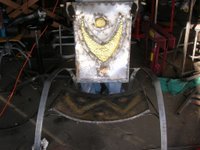
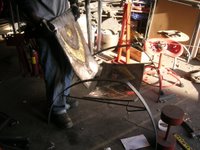
Please do stop by to see which one will be on display! We will be there during the opening reception on Friday.
HOURS:
Friday-10th : Opening Reception 5-10 p.m.
Saturday-11th : Noon-6:00 p.m.
Sunday-12th: Noon-3:00 p.m.
LOCATION:
The Grainbelt Bottling House
Monday, October 23, 2006
Cotton, Clothes and All That Jazz
According to a photo journal on the BBC, Burkina is the 2nd largest producer of cotton in Africa, after Egypt. This is astounding to me since I myself never really saw it when I lived in Burkina. But then again, it's grown primarily in the southern part of the country. One other interesting note is that the US is the largest exporter of cotton in the world.
One organization that's doing a lot of work around the American subsidies is Oxfam. I first became aware of Oxfam's work with cotton subsidies during a concert by Malian singer Habib Koite in early 2005. Habib is an amazing artist and the Make Fair Trade signs around the Cedar Cultural Center definitely alerted me to the issue. Habib is actually coming back to Mpls next month for the tour Putumayo Presents: Acoustic Africa. Some of the proceeds from the album will be donated to the Make Fair Trade campaign as well.
Oxfam also had a number of African farmers travel throughout the US in April 2006 to speak about production in their countries and to learn about the cotton industry here. One Burkinabe farmer, Seydou Ouedraogo, actually came to MN to speak. Seydou spoke to folks in Willmar and Lewiston. Here's his bio:
Ouedraogo is cotton producer from the village of Tabou in the Sissili Province of Burkina Faso. He farms a 10-acre cotton field for profit and a five-acre cereal field for subsistence farming. Ouedraogo is also the deputy secretary general of the National Union of Cotton Growers in Burkina (UNPC/B,) an organization created in 1998 to support the country’s cotton producers. He is also the deputy secretary general of the Farmers’ Confederation of Burkina Faso (CPF), a national platform composed of all national professional organizations. Ouedraogo is married and has one daughter.
We unfortanately were unable to attend his events since he was here the same weekend as the April St. Paul Art Crawl. But we did have a BBQ for him on the eve of his return to Burkina. It was very exciting to have him to our place and to hear the lively conversations that ensued with our guests. Katie Danko (the Oxfam field organizer); RPCVs from Burkina, Lesotho, Kenya, DRC; friends from Mali, Burkina and Kenya; and others interested in the topic attended on that brisk spring evening.
 I find it interesting to compare clothing traditions in East Africa vs West Africa. I think second hand clothes are much more readily available in East Africa (I can only speak for Kenya and Uganda) and they are cheaper than having an outfit made. To a certain degree, this is also true in Burkina (that 2nd hand clothes are cheaper than having an outfit made) but outfits are always made for special occasions or holidays. You definitely find more 2nd hand clothes in the cities and more Western influence as well in peoples' dress. Looking into this crowd of rural folks, you don't see a ton of Western clothes.
I find it interesting to compare clothing traditions in East Africa vs West Africa. I think second hand clothes are much more readily available in East Africa (I can only speak for Kenya and Uganda) and they are cheaper than having an outfit made. To a certain degree, this is also true in Burkina (that 2nd hand clothes are cheaper than having an outfit made) but outfits are always made for special occasions or holidays. You definitely find more 2nd hand clothes in the cities and more Western influence as well in peoples' dress. Looking into this crowd of rural folks, you don't see a ton of Western clothes.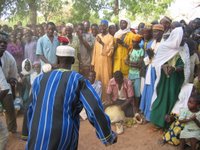 My hypothesis is since cotton is grown in Burkina, many Burkinabe still wear traditional clothes. The traditional dress for Mossi women is an indigo pagne (wrap skirt) which is often handwoven and dyed in their village. Men wear loose shirts with big pockets in the front. And then there is the boubou for both men and women as shown below. I think this picture of PCVs is a good example of the range in fabric types. You have wax fabric, Mauritanian fabric, Faso dan Fani, and wax again. Note the embroidery, which is found on both womens and mens wear.
My hypothesis is since cotton is grown in Burkina, many Burkinabe still wear traditional clothes. The traditional dress for Mossi women is an indigo pagne (wrap skirt) which is often handwoven and dyed in their village. Men wear loose shirts with big pockets in the front. And then there is the boubou for both men and women as shown below. I think this picture of PCVs is a good example of the range in fabric types. You have wax fabric, Mauritanian fabric, Faso dan Fani, and wax again. Note the embroidery, which is found on both womens and mens wear.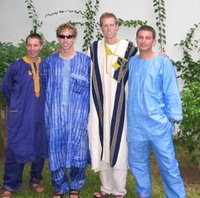 So, getting back to my original point of this posting, some of our imports are fabrics! We have gode, kente, mudcloth, wax, Mauritanian, indigo, etc etc. We have turned these raw pieces into shower curtains, window curtains, wall hangings, stool covers, bed spreads, pillows, rugs, etc etc. I think some Americans get freaked out by African fabrics because they just don't know what to do with it. There's a lot we can make with these products and we have to ensure that local Burkinabe farmers aren't put out of business.
So, getting back to my original point of this posting, some of our imports are fabrics! We have gode, kente, mudcloth, wax, Mauritanian, indigo, etc etc. We have turned these raw pieces into shower curtains, window curtains, wall hangings, stool covers, bed spreads, pillows, rugs, etc etc. I think some Americans get freaked out by African fabrics because they just don't know what to do with it. There's a lot we can make with these products and we have to ensure that local Burkinabe farmers aren't put out of business.Friday, October 20, 2006
NEED Magazine
The premiere issue includes a story about the ARC and photos by St Paul based photographer Linda Cullen. I met Linda back in 2001 and her work is beautiful.
I'm already looking forward to the next issue.
Monday, October 16, 2006
New Pieces
Tuesday, October 10, 2006
Africa 911
Give Us Wings works with local groups in villages in Kenya and Uganda. Since I got my first taste of Africa in these two countries (in Kenya through the Minnesota Studies in International Development and in Uganda through Kamwokya Child Care Community), I fully support this organization's mission.
It's not quite related to Burkina Faso or West Africa, but still come!
Monday, October 02, 2006
HealthPartners Tapestry
Friday, September 29, 2006
Mark Your Calendars
Saturday, October 14 at 12-7pm
Sunday, October 15 at 12-5pm
Northwestern Bldg (#3 on map)
275 E 4th St, St Paul
Room 600


We will again be sharing the room with Fair Trade Federation member Alsadu, Inc. Invite your friends.
Tuesday, September 19, 2006
Meet Sidonie
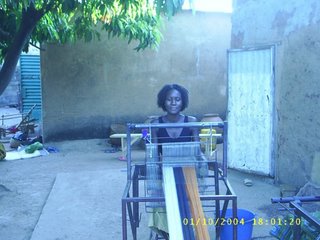 Once upon a SIAO, I bought my first Sidonie bag. It was a sturdy yellow over-the-shoulder bag with purple embroidery and a bead closure. I loved it and thought the seller, Sidonie, was a genius designer in her early 20's. Although she sold her bags at stores in Ouaga, I thought all Peace Corps volunteers needed a Sidonie bag. So, she would come to the Peace Corps hostel, and girls would buy. We talked how she could change the styles and she did custom orders. Eventually, she started putting zippers in most of the bags, instead of clasps. All of the bags are lined with a pocket inside. Some have leather handles, other cloth.
Once upon a SIAO, I bought my first Sidonie bag. It was a sturdy yellow over-the-shoulder bag with purple embroidery and a bead closure. I loved it and thought the seller, Sidonie, was a genius designer in her early 20's. Although she sold her bags at stores in Ouaga, I thought all Peace Corps volunteers needed a Sidonie bag. So, she would come to the Peace Corps hostel, and girls would buy. We talked how she could change the styles and she did custom orders. Eventually, she started putting zippers in most of the bags, instead of clasps. All of the bags are lined with a pocket inside. Some have leather handles, other cloth.Many bags later, we have become friends and business associates. The fabric is woven in her family's courtyard, Sidonie designs the bags, and she has the final sewing done outside. She also dabbled in making scarves and beaded belts, but I'm not sure if she's still doing this. I have samples of both, of course. She originally started working with a French woman but I'm not sure why they didn't continue working together. So you can find similar bags in Ouaga, since the French woman still makes them.
 When I moved back to the US in 2004, I bought some Sidonie bags to sell at a Locks of Love benefit in a suburb of Minneapolis. All the women at this event (about 150) preferred to buy the designer knock-offs and I only sold 1 Sidonie bag that night. Made me really wonder about suburban women and what they value. I eventually sold all of the bags to friends and family. Then in October 2005, we had a small sample booth at the St. Paul Art Crawl. People were begging to buy my used Sidonie bags! I have quite the collection. So we brought a bunch in for the St. Paul Art Crawl in April 2006, but this time had little interest.
When I moved back to the US in 2004, I bought some Sidonie bags to sell at a Locks of Love benefit in a suburb of Minneapolis. All the women at this event (about 150) preferred to buy the designer knock-offs and I only sold 1 Sidonie bag that night. Made me really wonder about suburban women and what they value. I eventually sold all of the bags to friends and family. Then in October 2005, we had a small sample booth at the St. Paul Art Crawl. People were begging to buy my used Sidonie bags! I have quite the collection. So we brought a bunch in for the St. Paul Art Crawl in April 2006, but this time had little interest.I'm not sure what this means exactly. Maybe the colors are generally too bright for Midwesterners? I had one specially made for my 93 year old grandma a few years back and she loves it. It's purple and green, her favorite colors.
In the meantime, we're just trying to find a good market for her bags. Someone suggested NYC or Chicago. I think we should be able to find our niche here. A friend in Accra, Ghana said she saw 2 girls walking down the street with what looked like to be Sidonie bags. So there is seemingly interest...
Here are a few samples of her bags; no two bags are alike, though the color schemes can be similar and the sizes the same.
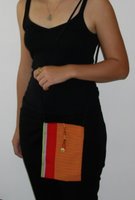
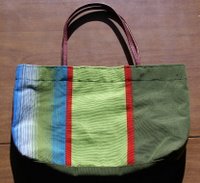
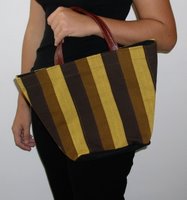
Friday, September 08, 2006
"It's a fair trade product!"
According to the FTF, fair trade means. "Producers receive a fair wage when they are paid fairly for their products. This means that workers are paid at least that country's minimum wage. Since the minimum wage is often not enough for basic survival, whenever feasible, workers are paid a living wage, which enables them to cover basic needs, including food, shelter, education and health care for their families. Paying fair wages does not necessarily mean that products cost the consumer more. Since fair trade organizations bypass exploitative middlepeople and work directly with producers, they are able to cut costs and return a greater percentage of the retail price to the producers."
And what are the membership criteria?
- Paying a fair wage in the local context.
- Offering employees opportunities for advancement.
- Providing equal employment opportunities for all people, particularly the most disadvantaged.
- Engaging in environmentally sustainable practices.
- Being open to public accountability.
- Building long-term trade relationships.
- Providing healthy and safe working conditions within the local context.
- Providing financial and technical assistance to producers whenever possible.
 So be sure to look for the logo!
So be sure to look for the logo!Friday, August 25, 2006
EarthFusion Tomorrow
Saturday: 10am-10pm, Sunday: 10am-7pm
Roseville Central Park Amphitheater
2540 Lexington Ave North, Roseville, MN
EarthFusion empowers youth for social change by celebrating a peaceful, sustainable and just Earth through music and the arts. EarthFusion seeks to bring together an ethnically and economically diverse group of young people from the metropolitan area and across the United States in order to make connections with one another and bring about social justice and environmental sustainability. Tickets are $20 for a two-day pass or $15 per day.
I'm hoping it will be a good time and that young people will really show up. It's a great idea; I'm just nervous about the publicity and organization since it's the first year. We'll see. Rabi will be selling some new candleholders and his waterboy piggy banks. And we'll be selling our imports as well.
Thursday, August 17, 2006
Dunn Brothers Display
We had a reception in late July, and got to see some good friends and meet new ones. Thanks Jenni for bringing all your colleagues! We also had African drummers, William and Matt, perform. That definitely added to the ambiance.
If you can't make it down, these are the items on display. We have these items in the back room on top of the bathroom:
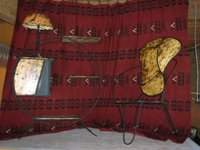 Burkinabe Living Room
Burkinabe Living RoomAll items for sale. Custom orders available.
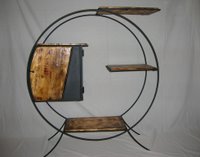 Entertainment Center
Entertainment Center 38x12x45
Pine & Metal
$300
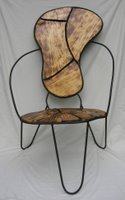 Picasso Chair #2
Picasso Chair #228x30x46
Pine & Metal
$200
 Baobab Lamp
Baobab Lamp22" high
Gourd & Metal
$100
 Mudcloth
Mudcloth116x84
Cotton & Natural Dyes
$175
We have these items above the ordering counter when you first walk in:
 Music Madness
Music MadnessAll items for sale. Made in Burkina Faso.
 Kora
KoraWood, Gourd & Leather
$200
 Balafon
BalafonWood & Gourd
$150
 Lounga (Talking Drum)
Lounga (Talking Drum)Wood & Leather
$100
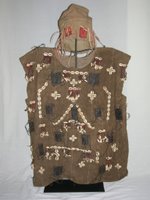 Dancer's Outfit
Dancer's OutfitCotton, Natural Dyes & Cowry
$100
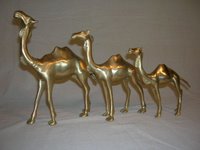 Camel Family
Camel FamilyBronze
$200










